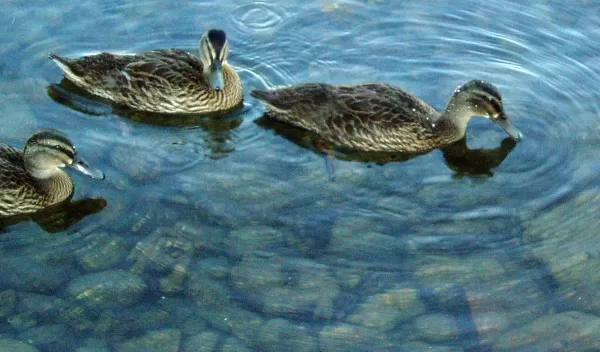
Benefits of Sexual Reproduction Lie in Defense Against Parasites
Since Darwin's time, biologists have tried to understand the advantages of sexual reproduction. This is not trivial because there are clear disadvantages to sex.
Unlike sexual organisms, asexuals do not need a partner to reproduce, they can reproduce clonally and they can produce twice as many female offspring. If there were no advantages to sex, and if both sexual and asexual individuals were competing for resources, the asexuals would take over in only a few generations.
Despite this, most eukaryotic organisms reproduce sexually, and the great mystery is that mixed sexual-asexual populations do occur in nature.
For over 20 years, this enigma has been explored by my advisor, Curtis Lively at Indiana University, and his students and colleagues. Our lab has found support for a hypothesis that sex is beneficial in parasite-rich environments.
The Red Queen Hypothesis
The Red Queen Hypothesis proposes that virulent parasites adapt to infect genetically common hosts, preventing asexuals from becoming too abundant (common is bad). Sex produces genetically unique individuals that can avoid infection (rare is good), and are thus favored by natural selection.
The hypothesis is named after a passage in Lewis Carroll's "Through the Looking Glass". The Red Queen and Alice run over hills and valleys, but always remain in the same place. Likewise, according to the hypothesis, genetic change in a population is necessary to maintain the status quo. Frequencies of asexual hosts increase (hills) and decrease (valleys) in response to parasite adaptation, while sexual hosts can avoid these coevolutionary ups and downs.
Ultimately, these dynamics over generations prevent an asexual take-over and maintain the coexistence of asexuals and sexuals.
Adaptation of local parasites
Potamopyrgus antipodarum is a New Zealand freshwater snail that reproduces either sexually or clonally, and does not switch modes during its lifetime. As a population, the snails can be asexual or mixtures of asexual and sexual individuals.
In 1987, while comparing mixed snail populations with entirely asexual populations, Lively found the former were more heavily infected by a sterilizing worm parasite. This was the first hint that a high rate of parasite infection in the snail population promotes the coexistence of sexual and asexual populations.
Since then, several experiments have shown these parasites are better able to infect snails from the same lake than from different lakes. This suggests parasites are adapted to better infect snails only in the local mixed population, a prediction of the Red Queen Hypothesis.
The association between parasite adaptation and sexual reproduction in snails led Lively, our collaborators, Lynda Delph and Jukka Jokela, and me to investigate such a pattern within Alexandrina and Kaniere lakes in New Zealand.
In each lake, sexual snails and parasites are common in shallow-water margins, and deep habitats (more than four-meters depth) are dominated by uninfected asexuals. We hypothesized that sexuals had an advantage over asexuals in the shallow water due to coevolving parasites, but not in the deep where parasites are absent.
However, an alternative explanation is that the shallow-water snails are susceptible, in general. We had to determine whether shallow-water snails were susceptible specifically to local, same-lake parasites or to all parasites, regardless of location. The Red Queen would predict the former because the local parasites would have the best opportunity to coevolve with the snails.
Parasites are abundant in shallow water because of the foraging behavior of ducks. Parasite larvae must be ingested by ducks to complete the parasites' life cycle (ducks accidentally eat the infected snails). Ducks do not forage in deep habitats, so parasites can only complete their life cycle in shallow habitats. It seems there is more selection of the snails and parasites in the shallow since in the deep, snails and parasites rarely encounter each other.
Our experimental design was simple: take shallow- and deep-water snails and expose them to parasites collected from the same lakes and from different lakes. We found two interesting results.
First, shallow-water snails were more infected by same-lake parasites than were deep-water snails, suggesting parasites coevolve only with snails in the shallow habitats. Deep-water snails do not partake in the coevolutionary interactions just meters away.
Secondly, neither shallow- nor deep-water snails were susceptible to different-lake parasites. Therefore, only local (i.e., coevolving) parasites, and not parasites from just anywhere, can infect shallow snails.
Common is bad, rare is good
From our experiment, we found support for the Red Queen Hypothesis and demonstrated its application to small spatial scales in nature. We showed that parasites are adapted to the snail populations where sexuals and asexuals coexist in shallow water.
In a related study, Lively and Jokela demonstrated that as parasites adapt to infect asexual snails in the shallow water, they indeed favor sex, as predicted by the Red Queen Hypothesis. Snails that were genetically common and highly infected by parasites were rare. Snails that were genetically uncommon and previously resistant to parasites became common and infected. All the while, sexual snails persisted in the shallow water. This was the first time anyone demonstrated that Red Queen dynamics maintained sexual reproduction.
Despite the costs of sexual reproduction, it seems to have use against parasites. Sexual organisms are genetically rare, and consequently, parasites cannot adapt to them. Evidence from the New Zealand snails shows that parasite adaptation to infect common asexual individuals prevents asexuals from eliminating sexuals from the population.
More research in other organisms with both reproductive modes would greatly benefit our understanding of the advantages to sex and the dynamics underlying asexual-sexual coexistence.
For more, see the Indiana University press release.
-- Kayla King, Indiana University, kingkc@indiana.edu
This Behind the Scenes article was provided to LiveScience in partnership with the National Science Foundation.


